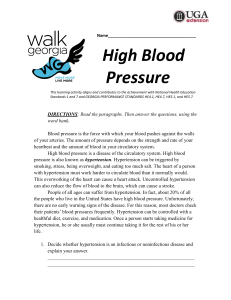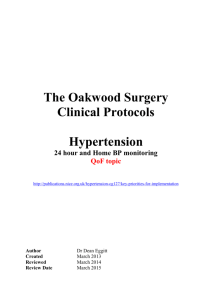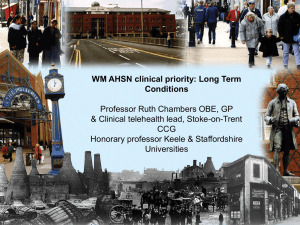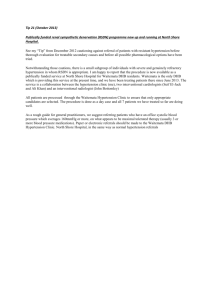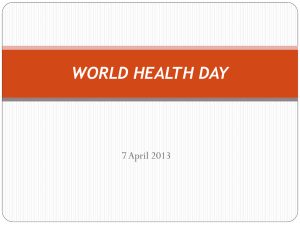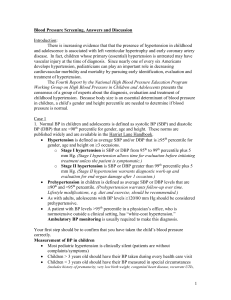DOCX ENG
advertisement
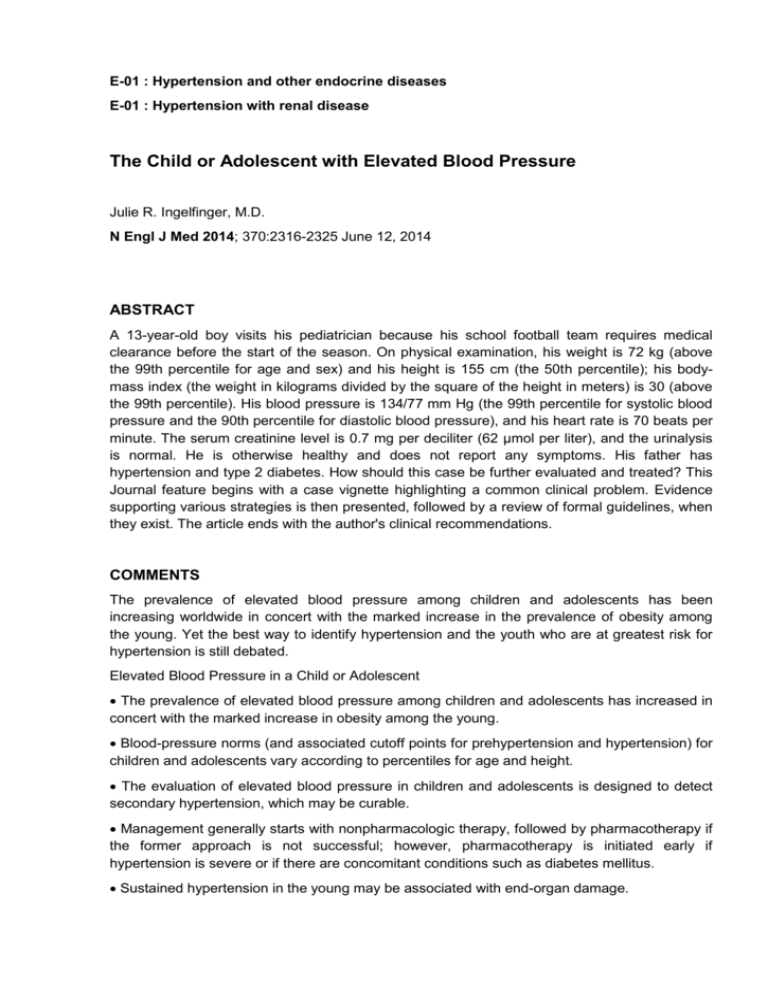
E-01 : Hypertension and other endocrine diseases E-01 : Hypertension with renal disease The Child or Adolescent with Elevated Blood Pressure Julie R. Ingelfinger, M.D. N Engl J Med 2014; 370:2316-2325 June 12, 2014 ABSTRACT A 13-year-old boy visits his pediatrician because his school football team requires medical clearance before the start of the season. On physical examination, his weight is 72 kg (above the 99th percentile for age and sex) and his height is 155 cm (the 50th percentile); his bodymass index (the weight in kilograms divided by the square of the height in meters) is 30 (above the 99th percentile). His blood pressure is 134/77 mm Hg (the 99th percentile for systolic blood pressure and the 90th percentile for diastolic blood pressure), and his heart rate is 70 beats per minute. The serum creatinine level is 0.7 mg per deciliter (62 μmol per liter), and the urinalysis is normal. He is otherwise healthy and does not report any symptoms. His father has hypertension and type 2 diabetes. How should this case be further evaluated and treated? This Journal feature begins with a case vignette highlighting a common clinical problem. Evidence supporting various strategies is then presented, followed by a review of formal guidelines, when they exist. The article ends with the author's clinical recommendations. COMMENTS The prevalence of elevated blood pressure among children and adolescents has been increasing worldwide in concert with the marked increase in the prevalence of obesity among the young. Yet the best way to identify hypertension and the youth who are at greatest risk for hypertension is still debated. Elevated Blood Pressure in a Child or Adolescent The prevalence of elevated blood pressure among children and adolescents has increased in concert with the marked increase in obesity among the young. Blood-pressure norms (and associated cutoff points for prehypertension and hypertension) for children and adolescents vary according to percentiles for age and height. The evaluation of elevated blood pressure in children and adolescents is designed to detect secondary hypertension, which may be curable. Management generally starts with nonpharmacologic therapy, followed by pharmacotherapy if the former approach is not successful; however, pharmacotherapy is initiated early if hypertension is severe or if there are concomitant conditions such as diabetes mellitus. Sustained hypertension in the young may be associated with end-organ damage. Available data suggest that therapy to lower blood pressure can reverse end-organ damage. The most recent references related to the diagnosis and treatment of hypertension in children ans adolescents is providen in the article. Here are reproduced the various thresholds that need further diagnosis evaluation according to age (table 1) The conclusions given by Dr Ingelfinger are as follows : The 13-year-old boy described in the vignette has elevated blood pressure that may be categorized as stage 1 hypertension, and he is also obese. He probably has primary hypertension, but he should undergo a careful history taking and physical examination (including a retinal examination), basic laboratory tests, echocardiography, and renal ultrasonography to screen for underlying renal disease. I would first institute a trial of lifestyle changes, including a low-salt, high-potassium, weight-control diet and exercise, and I would make a strong effort to enlist the support of his family, teachers, and other adults. I would recommend frequent follow-up to monitor his weight, fitness, and blood pressure, and I would encourage a program of dynamic exercise. If his blood pressure did not decrease to nonhypertensive levels after 6 to 12 months of nonpharmacologic therapy, I would consider instituting pharmacotherapy. In the absence of a sufficient number of head-to-head medication trials involving children and adolescents to guide the choice of therapy, any of several classes of medication studied in children would be acceptable. I would probably start with an ACE inhibitor, provided that there were no contraindications, since it is unlikely that this class of medications would affect his running or endurance. Table 1. Blood – Pressure Thresholds Indicating the Need for Further Evaluation? Intervention? Or Both.* Years of Age Boys МBoys and Girls Girls SBD DBP SBD DBP SBD DBP 3 100 59 100 61 ≥ 100 > 60 4 102 62 101 64 ≥ 100 > 60 5 104 65 103 66 ≥ 100 > 60 6 105 68 104 68 ≥ 105 > 70 7 106 70 106 69 ≥ 105 > 70 8 107 71 108 71 ≥ 105 > 70 9 109 72 110 72 ≥ 110 > 75 10 111 73 112 73 ≥ 110 > 75 11 113 74 114 74 ≥ 110 > 75 12 115 74 116 75 ≥ 115 > 75 13 117 75 117 76 ≥ 115 > 75 14 120 75 119 77 ≥ 115 > 75 15 120 76 120 78 ≥ 120 > 80 16 120 78 120 78 ≥ 120 > 80 17 120 80 120 78 ≥ 120 > 80 ≥ 18 120 80 120 80 ≥ 120 > 80 * The threshold for further evaluation or intervention is based on cutoff points for hypertension from the fourth report of the National High Blood Pressure Education Program Working Group on High Blood Pressure in Children and Adolescents4. DBP denotes diastolic blood pressure, and SBP denotes systolic blood pressure. (1) – Data are from Kaelber and Pickett [11] (2) - Data are from Mitchell et al. [13] Pr. Jacques CHANARD Professor of Nephrology
